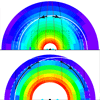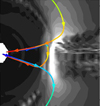
2012 THEMIS SCIENCE NUGGETS
SUMMARIES OF THEMIS RESEARCH
| <<View 2011 THEMIS Nuggets | Return to main page |
 J. Kissinger, May 2012
J. Kissinger, May 2012Diversion of plasma due to high pressure in the inner magnetosphere during steady magnetospheric convection.
During a substorm, which is the more common response of the magnetosphere, plasma and energy (or "flux") is reconnected in the magnetotail and then 'piles up' near the Earth in the inner magnetosphere. In order to maintain balanced reconnection during an SMC event, however, flux from the nightside needs to return to the dayside to reconnect with the solar wind once more. Read more.
 F. Jiang, May 2012
F. Jiang, May 2012In-situ observation of the "pre-existing auroral arc" by THEMIS All Sky Imagers and the FAST spacecraft.
In this study, we combined ground optical observations with in-situ measurements from low-altitude spacecraft flybys to provide insight into the pre-existing auroral arc’s source in the magnetosphere. Read more.
 L. Chen, March 2012
L. Chen, March 2012Amplification of whistler-mode hiss inside the plasmasphere
The access of chorus to form an embryonic source outside the plasmapause, together with internal amplification inside the plasmasphere using the observed electron distribution, can account for the spectral intensity of dayside plasmaspheric hiss.
Read more. L. Chen, March 2012
L. Chen, March 2012Modeling the Properties of Plasmaspheric Hiss
In these two companion papers, we use observed statistical distribution of chorus emission to model the characteristics of hiss spectrum and investigate the response of hiss emission to the variations of source chorus and of background plasma density distribution.
Read more. H. Fu, March 2012
H. Fu, March 2012The role of electrons during chorus intensification: Energy source and energy loss.
We investigate the dynamics of electrons, including the energy source and energy loss, during the chorus intensification processes, which are observed by THEMIS on November 19, 2007 in response to an interplanetary shock. We find that the energetic electrons act as the intermediate; they transfer energies carried by the interplanetary shock to the chorus. The lower-energy (~15 keV) electrons contribute more to the growth of chorus as they have larger density gradient and energy drop along the diffusion curves. Read more.
 J. Yang, March 2012
J. Yang, March 2012Large-scale current systems and ground magnetic disturbance during deep substorm injections.
In this study, we present a detailed analysis of the large-scale current systems and their effects on the ground magnetic field disturbance for an idealized substorm event simulated with the Rice Convection Model (RCM-E). Read more.
 E. V. Panov, March 2012
E. V. Panov, March 2012Observations of kinetic ballooning/interchange instability.
Signatures of kinetic ballooning/interchange instability were observed at 11 RE near presumed B-minimum. Electron-driven sausage(ballooning)-like ion gyroscale fingers were found drifting westward. The signatures were identified at off-equatorial location in the middle of plasma sheet. Read more.
 Xin Tao, March 2012
Xin Tao, March 2012Comparison between theory and observation of the frequency sweep rates of equatorial rising tone chorus.
The theoretical predications of chorus frequency sweep rates are compared with observations. Good agreement is found between theories and observations in terms of scaling. Read more.
 Andreas Keiling, February 2012
Andreas Keiling, February 2012Pi2 pulsations driven by ballooning instability.
Various generation scenarios for high-latitude Pi2 pulsations have been proposed in the literature. In this study, we provide evidence for ballooning-driven Pi2 pulsations, and we propose a propagation model for the ballooning-driven Pi2 to propagate to the ground. Read more.
 D.I. Golden, February 2012
D.I. Golden, February 2012Statistical modeling of plasmaspheric hiss amplitude using solar wind measurements and geomagnetic indices.
We have developed a linear model of plasmaspheric hiss amplitude using a diverse assortment of solar wind measurements and geomagnetic indices. Read more.
 J. Yang, February 2012
J. Yang, February 2012RCM-E simulation of the 13 March 2009 steady magnetospheric convection event.
In this study, we investigate how the "pressure-balance crisis" is avoided during the 2009-03-13 steady magnetospheric convection (SMC) event, with a series of numerical simulations using the Rice Convection Model-Equilibrium (RCM-E). Read more.
 Please send comments/suggestions to
Emmanuel Masongsong / emasongsong @ igpp.ucla.edu
Please send comments/suggestions to
Emmanuel Masongsong / emasongsong @ igpp.ucla.edu